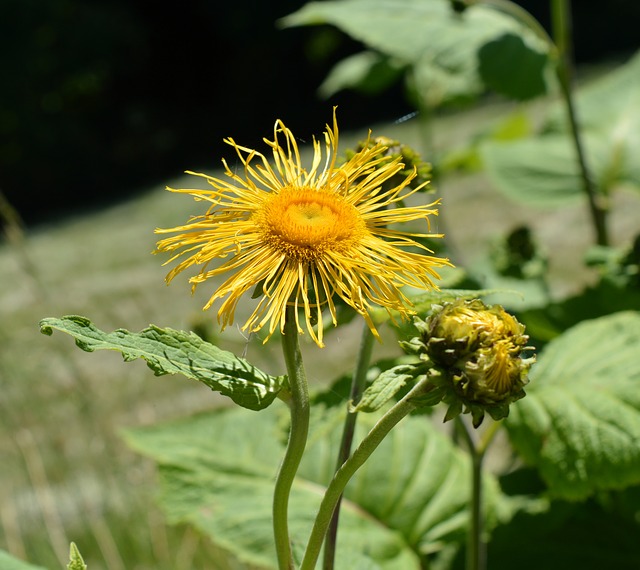Elecampane Root

Also known as Inula helenium, Alant, Aster helenium, Aster officinalis, Elfdock, Elfwort,Helenium grandiflorum, Horse-Elder, Horseheal, Scabwort, Velvet Dock, Wild Sunflower, Yellow Starwort.
Introduction Elecampane is a member of the same plant family as the sunflowers and ragweed, native to southern and eastern Europe but naturalized around the world. The 6- to 8-foot (200-250 cm) tall plant has large, pointed leaves with downy gray undersides and yellow summer flowers.
Constituents Bitter substances known as alanto-lactones and up to 45% inulin.
Parts Used Roots and rhizomes dug from 2- to 3-year-old plants, dried and cut.
Typical Preparations Usually taken as a tea. Added to cough syrups, expectorants, herbal diuretics, pain remedies, and having roborant properties (for bringing out color from pale skin). Can also be taken internally in the form of a capsule or extract.
Summary Elecampane is an antiseptic expectorant that relieves congestion in colds and bronchitis. As a bitter, it can also be used to stimulate digestion, and as an antifungal and helminthic, it can be used to treat yeast infections and parasites.
Precautions If you are allergic to ragweed, you may be allergic to elecampane. Taking too much of the herb can cause cramps and diarrhea. Do not use more than 1 gram (one-quarter teaspoon) of the herb in any one dose, or more than 3 grams (a little less than a teaspoon) in a day. Not to be used while pregnant. Some cases have been reported of nausea and vomiting, probably from over-use. Not recommended for long term use.
PURCHASE ELECAMPANE ROOT EXTRACT
For educational purposes only. This information has not been evaluated by the Food and Drug Administration. This information is not intended to diagnose, treat, cure, or prevent any disease.
This information courtesy of MOUNTAIN ROSE HERBS, with full, written permission for reuse. For further traditional information concerning Elecampane , please visit this excellent resource from Botanical.com. Used with full, written permission.







